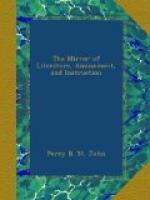Title: The Mirror of Literature, Amusement, and Instruction Volume 17, Number 489, Saturday, May 14, 1831
Author: Various
Release Date: June 16, 2004 [EBook #12634]
Language: English
Character set encoding: ASCII
*** Start of this project gutenberg EBOOK mirror of literature, no. 489 ***
Produced by Jonathan Ingram, David Garcia and the
Online Distributed
Proofreading Team.
THE MIRROR OF LITERATURE, AMUSEMENT, AND INSTRUCTION.
Vol. XVII, No. 489.] Saturday, may 14, 1831. [Price 2d.
* * * * *
ST. GEORGE’S HOSPITAL.
[Illustration: St. George’s hospital.]
All who enjoy the luxury of doing good (and who does not, in some way or other?) will be happy to learn that the above is the elevation of the new St. George’s Hospital, at Hyde Park Corner. It is already a splendid monument of British benevolence; but is only a portion of the original plan, which is to complete another front towards Hyde Park; this will extend even further than the old hospital.
St. George’s Hospital, we learn from a printed “Account,” “was set on foot soon after Michaelmas, 1733, by some gentlemen who were before concerned in a charity of the like kind, in the lower part of Westminster. They judged this house convenient for their purpose, on account of its air, situation, and nearness to town; procured a lease of it, and opened a subscription for carrying on the charity here. The subscriptions increased so fast, that on the nineteenth of October they were formed into a regular society, and actually began to receive patients on the first of January following.” The Establishment was, therefore, prosperous at its commencement, and the same good fortune has subsequently attended its progress. It is supported by Voluntary Contributions. The resources are considerable in property, and have been greatly enriched by legacies. Indeed, the legacies which fell to the Hospital during last year, exceeded 11,000l.
The building of the new Hospital, in the Engraving, was first proposed at a meeting held in the year 1827, at which the open-hearted Duke of York was chairman; and at a subsequent meeting, the Archbishop of Canterbury presided. A “Building Fund” was raised, to which the late King munificently contributed L1,000. This Fund is entirely separate from the General Funds of the Hospital: “the sums already subscribed” says the Report of 1830, “have been expended in erecting a part of the building which is now occupied by 140 patients, and the public are earnestly requested to keep in view the importance of continuing their benevolent contributions, until the great object of re-building the entire Hospital has been effected.” It is well known that the closeness of the wards in the old building has long been a subject of the deepest regret to the physicians and surgeons, who have observed its effect in preventing or retarding the cure of their patients; and this evil must, in some degree, be increased by the new building partially obstructing the ventilation of the old.




